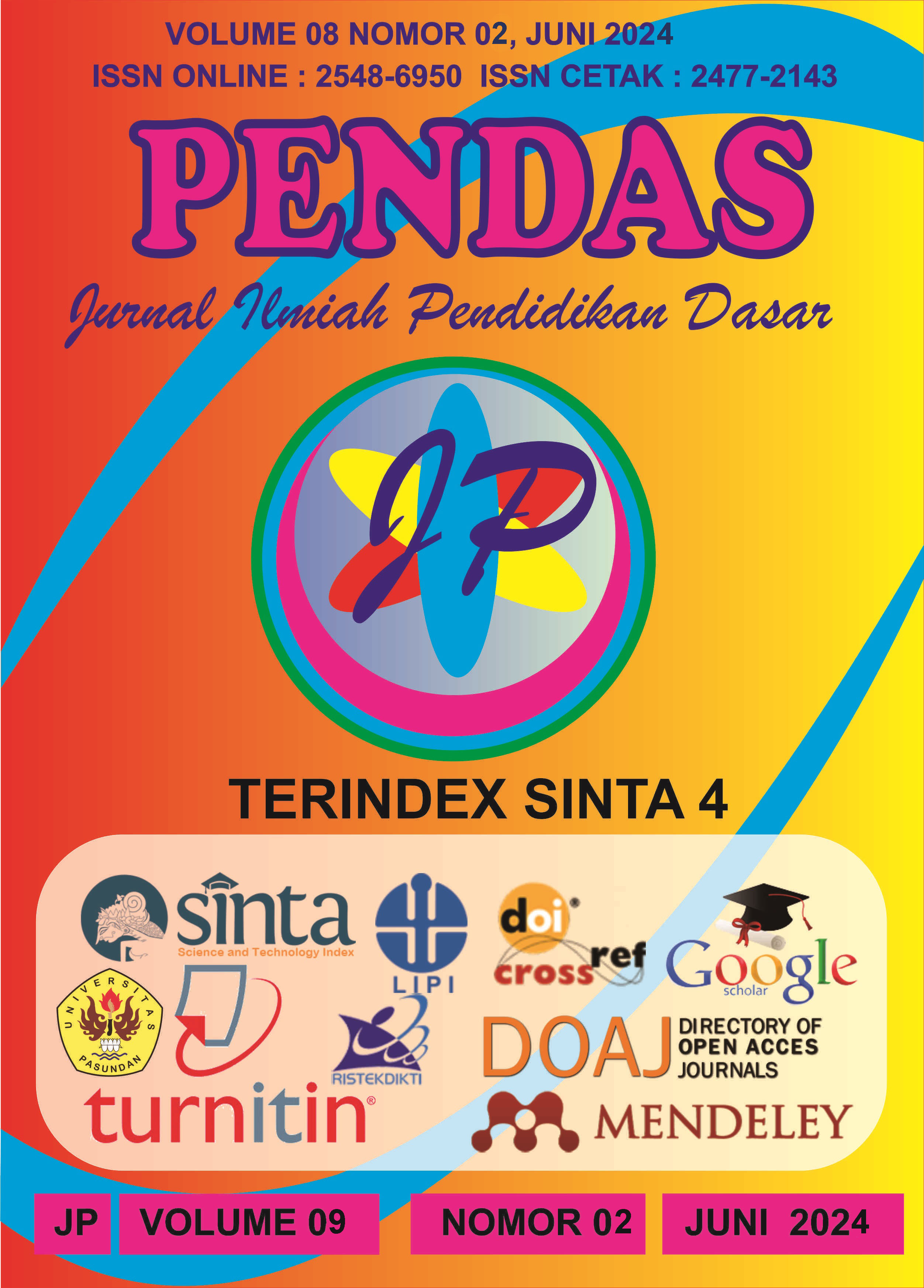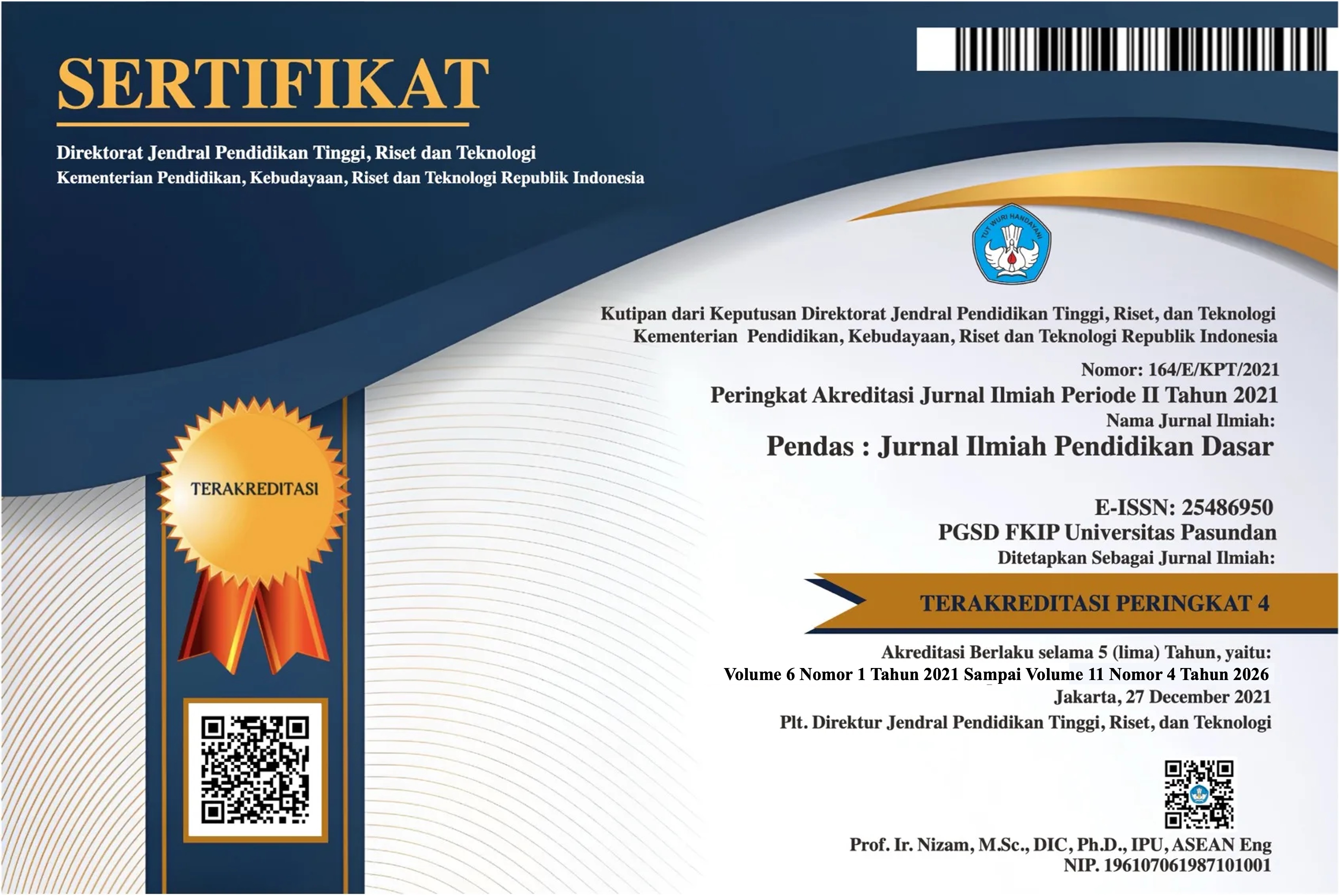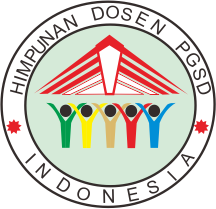LKPD CRT BANGUN RUANG SISI DATAR: UPAYA MENINGKATKAN KEMAMPUAN REPRESENTASI MATEMATIS SISWA
DOI:
https://doi.org/10.23969/jp.v9i2.14015Keywords:
culturally responsive teaching, representation, build a flat side roomAbstract
Solving problems in flat-sided geometric material will go through stages called representing the problem according to the student's abilities. Therefore, teachers must provide questions or LKPD that give students their imagination first before looking for appropriate solutions to contextual problems, so it is very possible to use the Culturally Responsive Teaching (CRT) approach. This research uses a type of experiment in the form of Classroom Action Research (PTK). The population of this research is SMPN 2 Pamekasan and the sample of this research is class VIII. This research instrument uses contextual questions and interviews. The results of this research. The mathematical representation of students in this research in the very good and good categories experienced a significant increase, especially in cycle II. In visual, verbal and symbolic representations, each representation experiences an increase in each cycle. So that students' abilities in representing problems mathematically in this research have greatly improved. Meanwhile, for student learning outcomes. It is proven that there is an increase in the average score of students achieving the KTTP set at school and an increase in students' learning completeness. The average score of students is 57.5 (pre cycle), 69 (cycle I), 80 (cycle II). The percentage of students' learning completeness is 37.5% (pre cycle), 59.4% (cycle I), 72% (cycle II).Downloads
References
Ana Quthratun Nada, Rizki Isma Wulandari, & Saleh. (2023). Meningkatkan Asesmen For Learning Remidial, Dan Pengayaan, Pendekatan Acuan Patokan (PAP) dan Pendekatan Acuan Normatif (PAF). Jurnal Ilmiah PGSD FKIP Universitas Mandiri, 9 (2).
Hartini H, & Patang P. (2022). Penerapan Model Pembelajaran Problem Based Learning Untuk Meningkatkan Hasil Belajar Peserta Didik. Jurnal Pendidikan Teknologi Pertanian, 8(2), 249. doi:https://doi.org/10.26858/jptp.v8i2.30287
Herminarto Sofyan., dkk. (2017). PROBLEM BASED LEARNING DALAM KURIKULUM 2013. Yogyakarta: UNY Press.
Junita, M., Ahmad, R., Fauzan, A., & Arief, D. (2022). Pengaruh Pendekatan Open Ended dan Gender untuk Meningkatkan Kemampuan Representasi Matematis Siswa Sekolah Dasar. Jurnal Basicedu, 6(2), 2380–2390. doi:https://doi.org/10.31004/basicedu.v6i2.2466
Kuryani, Heni Lestari & Tutus. (2023). “Prinsip Pengajaran dan Asesmen”. Jakarta: Direktorat Pendidikan Profesi Guru Direktorat Jenderal Guru dan Tenaga Kependidikan Kementerian Pendidikan, Kebudayaan, Riset dan Teknologi.
Muhammad Tareq Ghifari, Eka Firmansyah, & Hania Rahmah. (2023). Peningkatan Kemampuan Literasi Matematis melalui Model Discovery Learning dengan Pendekatan Culturally Responsive Teaching. Pasundan Journal of Mathematics Education: Jurnal Pendidikan Matematika, 134-150. Vol (3) No. 2. doi:DOI: 10.23969/pjme.v13i2.10020
Mulyadi, N. A., & Fiangga, S. (2021). Analisis Kemampuan Representasi Siswa Dalam Menyelesaikan Soal. Jurnal Ilmiah Soulmath : Jurnal Edukasi Pendidikan Matematika, 9(2), 143–152. doi:https://doi.org/10.25139/smj.v9i2.3938
NCTM. (2000). Principle and Standards for Schools Mathematics.
OECD. (2018). Result tahun 2018 (PISA). OECD.
OECD. (2022). PISA 2022 Result The State of Learning and Equity in Education. Penerbit: OECD.
Rahmat, A. S. (2021). Pengaruh Means Ends Analysis Berbasis Media Kartu Kendali Literasi Digital Terhadap Kemampuan Numerasi Representasi Matematis Siswa Sekolah Dasar. Jurnal Penelitian Kebijakan Pendidikan, 14(2), 83–96. doi:https://doi.org/10.24832/jpkp.v14i2.534
Rizki Nurintan Purnama, Imam Kusmaryono & Mohammad Abdu Basir. (2019). Analisis Kemampuan representasi Matematis Siswa Kelas VIII SMP Al Fattah Semarang. Jurnal Penelitian Didaktik matematika, 3 (1).
Seftyana Ayu Susanti, Mega Teguh Budiarto & Rini Setianingsih. (2023). Analisis Kemampuan Pemecahan Masalah Numerasi Siswa Berdasarkan Tingkat Kecemasan Matematis. JRPM (Jurnal Review Pembelajaran Matematika), 18-32 8(1).
Setiana, A. D. (2019). PENGEMBANGAN BAHAN AJAR MATEMATIKA BERBASIS ETNOMATEMATIKA KRATON YOGYAKARTA. AKSIOMA: Jurnal Program Studi Pendidikan Matematika, 11-19. Vol 8. doi:https://doi.org/10.24127/ajpm.v8i1.1630
Setianingsih, R. M. (2021). Students’ Mathematical Literacy in Solving PISA Problem Using Indonesian Cultural Context. JRPM (Jurnal Review Pembelajaran Matematika), 6(1), 52-67 .
Ummi Ma’rifah, P. W. (2023). ANALISIS KEMAMPUAN REPRESENTASI MATEMATIS PESERTA DIDIK DALAM MENYELESAIKAN SOAL LITERASI NUMERASI DITINJAU DARI PERBEDAAN JENIS KELAMIN. DE_JOURNAL (Dharmas Education Journal), 77-82 , Vol 4. Diambil kembali dari http://ejournal.undhari.ac.id/index.php/de_journal
Downloads
Published
Issue
Section
License
Copyright (c) 2024 Pendas : Jurnal Ilmiah Pendidikan Dasar

This work is licensed under a Creative Commons Attribution 4.0 International License.



















